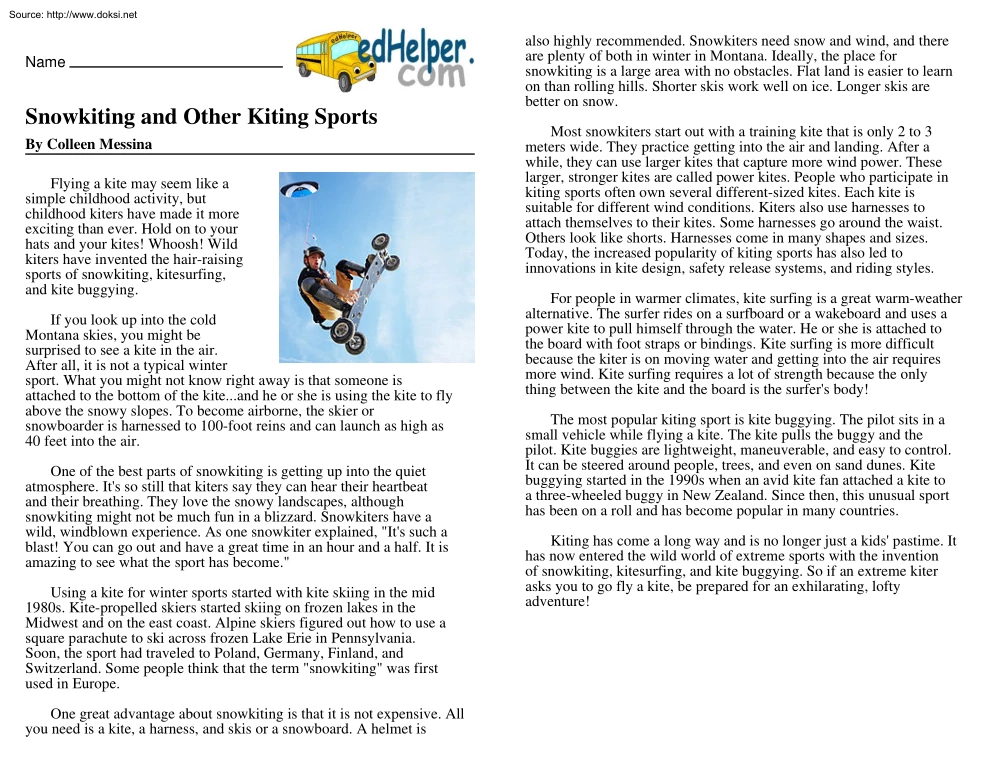Datasheet
Year, pagecount:2018, 3 page(s)
Language:English
Downloads:1
Uploaded:December 10, 2018
Size:477 KB
Institution:
-
Comments:
Attachment:-
Download in PDF:Please log in!
Comments
No comments yet. You can be the first!Most popular documents in this category
Content extract
Source: http://www.doksinet Name Snowkiting and Other Kiting Sports By Colleen Messina Flying a kite may seem like a simple childhood activity, but childhood kiters have made it more exciting than ever. Hold on to your hats and your kites! Whoosh! Wild kiters have invented the hair-raising sports of snowkiting, kitesurfing, and kite buggying. If you look up into the cold Montana skies, you might be surprised to see a kite in the air. After all, it is not a typical winter sport. What you might not know right away is that someone is attached to the bottom of the kite.and he or she is using the kite to fly above the snowy slopes. To become airborne, the skier or snowboarder is harnessed to 100-foot reins and can launch as high as 40 feet into the air. One of the best parts of snowkiting is getting up into the quiet atmosphere. Its so still that kiters say they can hear their heartbeat and their breathing. They love the snowy landscapes, although snowkiting might not be much fun in a
blizzard. Snowkiters have a wild, windblown experience. As one snowkiter explained, "Its such a blast! You can go out and have a great time in an hour and a half. It is amazing to see what the sport has become." Using a kite for winter sports started with kite skiing in the mid 1980s. Kite-propelled skiers started skiing on frozen lakes in the Midwest and on the east coast. Alpine skiers figured out how to use a square parachute to ski across frozen Lake Erie in Pennsylvania. Soon, the sport had traveled to Poland, Germany, Finland, and Switzerland. Some people think that the term "snowkiting" was first used in Europe. One great advantage about snowkiting is that it is not expensive. All you need is a kite, a harness, and skis or a snowboard. A helmet is also highly recommended. Snowkiters need snow and wind, and there are plenty of both in winter in Montana. Ideally, the place for snowkiting is a large area with no obstacles. Flat land is easier to learn on than
rolling hills. Shorter skis work well on ice Longer skis are better on snow. Most snowkiters start out with a training kite that is only 2 to 3 meters wide. They practice getting into the air and landing After a while, they can use larger kites that capture more wind power. These larger, stronger kites are called power kites. People who participate in kiting sports often own several different-sized kites. Each kite is suitable for different wind conditions. Kiters also use harnesses to attach themselves to their kites. Some harnesses go around the waist Others look like shorts. Harnesses come in many shapes and sizes Today, the increased popularity of kiting sports has also led to innovations in kite design, safety release systems, and riding styles. For people in warmer climates, kite surfing is a great warm-weather alternative. The surfer rides on a surfboard or a wakeboard and uses a power kite to pull himself through the water. He or she is attached to the board with foot straps or
bindings. Kite surfing is more difficult because the kiter is on moving water and getting into the air requires more wind. Kite surfing requires a lot of strength because the only thing between the kite and the board is the surfers body! The most popular kiting sport is kite buggying. The pilot sits in a small vehicle while flying a kite. The kite pulls the buggy and the pilot. Kite buggies are lightweight, maneuverable, and easy to control It can be steered around people, trees, and even on sand dunes. Kite buggying started in the 1990s when an avid kite fan attached a kite to a three-wheeled buggy in New Zealand. Since then, this unusual sport has been on a roll and has become popular in many countries. Kiting has come a long way and is no longer just a kids pastime. It has now entered the wild world of extreme sports with the invention of snowkiting, kitesurfing, and kite buggying. So if an extreme kiter asks you to go fly a kite, be prepared for an exhilarating, lofty adventure!
Source: http://www.doksinet 6. Shorter skis work better on ice A. True B. False Name Snowkiting and Other Kiting Sports Questions 1. In which state is snowkiting already popular? A. Alaska B. Montana C. Wisconsin D. California 2. Where did kite skiing begin? A. Lake Michigan B. Crater Lake C. Lake Placid D. Lake Erie 3. How do kite surfers attach their feet to their boards? A. with rubber bands B. with bindings C. with superglue D. with tar 4. Which of the following is a synonym for the word maneuverable in paragraph 7? A. stubborn B. plastic C. mushy D. moveable 5. What attaches a kiter to his or her kite? A. boots B. a hat C. the power of positive thinking D. a harness 7. In what country did kite buggying begin? A. the United States B. Germany C. Finland D. New Zealand 8. What kind of kite is used in these kiting sports? A. extreme kites B. sporting kites C. power kites D. pretty kites Why do you think that kite buggying is the most popular extreme kiting sport? Would you like
to try it? Source: http://www.doksinet Name Which kind of kiting sport would you like to try most, and why?
blizzard. Snowkiters have a wild, windblown experience. As one snowkiter explained, "Its such a blast! You can go out and have a great time in an hour and a half. It is amazing to see what the sport has become." Using a kite for winter sports started with kite skiing in the mid 1980s. Kite-propelled skiers started skiing on frozen lakes in the Midwest and on the east coast. Alpine skiers figured out how to use a square parachute to ski across frozen Lake Erie in Pennsylvania. Soon, the sport had traveled to Poland, Germany, Finland, and Switzerland. Some people think that the term "snowkiting" was first used in Europe. One great advantage about snowkiting is that it is not expensive. All you need is a kite, a harness, and skis or a snowboard. A helmet is also highly recommended. Snowkiters need snow and wind, and there are plenty of both in winter in Montana. Ideally, the place for snowkiting is a large area with no obstacles. Flat land is easier to learn on than
rolling hills. Shorter skis work well on ice Longer skis are better on snow. Most snowkiters start out with a training kite that is only 2 to 3 meters wide. They practice getting into the air and landing After a while, they can use larger kites that capture more wind power. These larger, stronger kites are called power kites. People who participate in kiting sports often own several different-sized kites. Each kite is suitable for different wind conditions. Kiters also use harnesses to attach themselves to their kites. Some harnesses go around the waist Others look like shorts. Harnesses come in many shapes and sizes Today, the increased popularity of kiting sports has also led to innovations in kite design, safety release systems, and riding styles. For people in warmer climates, kite surfing is a great warm-weather alternative. The surfer rides on a surfboard or a wakeboard and uses a power kite to pull himself through the water. He or she is attached to the board with foot straps or
bindings. Kite surfing is more difficult because the kiter is on moving water and getting into the air requires more wind. Kite surfing requires a lot of strength because the only thing between the kite and the board is the surfers body! The most popular kiting sport is kite buggying. The pilot sits in a small vehicle while flying a kite. The kite pulls the buggy and the pilot. Kite buggies are lightweight, maneuverable, and easy to control It can be steered around people, trees, and even on sand dunes. Kite buggying started in the 1990s when an avid kite fan attached a kite to a three-wheeled buggy in New Zealand. Since then, this unusual sport has been on a roll and has become popular in many countries. Kiting has come a long way and is no longer just a kids pastime. It has now entered the wild world of extreme sports with the invention of snowkiting, kitesurfing, and kite buggying. So if an extreme kiter asks you to go fly a kite, be prepared for an exhilarating, lofty adventure!
Source: http://www.doksinet 6. Shorter skis work better on ice A. True B. False Name Snowkiting and Other Kiting Sports Questions 1. In which state is snowkiting already popular? A. Alaska B. Montana C. Wisconsin D. California 2. Where did kite skiing begin? A. Lake Michigan B. Crater Lake C. Lake Placid D. Lake Erie 3. How do kite surfers attach their feet to their boards? A. with rubber bands B. with bindings C. with superglue D. with tar 4. Which of the following is a synonym for the word maneuverable in paragraph 7? A. stubborn B. plastic C. mushy D. moveable 5. What attaches a kiter to his or her kite? A. boots B. a hat C. the power of positive thinking D. a harness 7. In what country did kite buggying begin? A. the United States B. Germany C. Finland D. New Zealand 8. What kind of kite is used in these kiting sports? A. extreme kites B. sporting kites C. power kites D. pretty kites Why do you think that kite buggying is the most popular extreme kiting sport? Would you like
to try it? Source: http://www.doksinet Name Which kind of kiting sport would you like to try most, and why?





